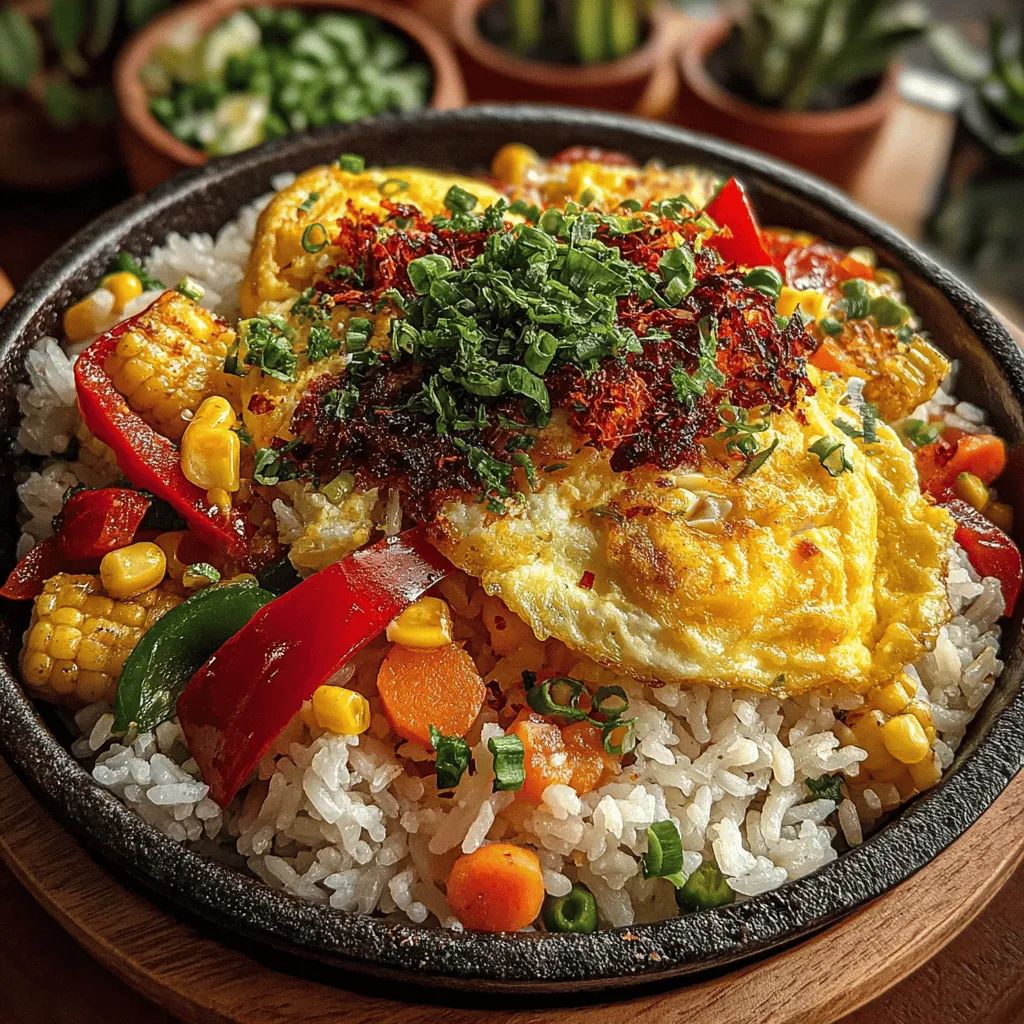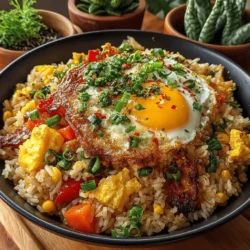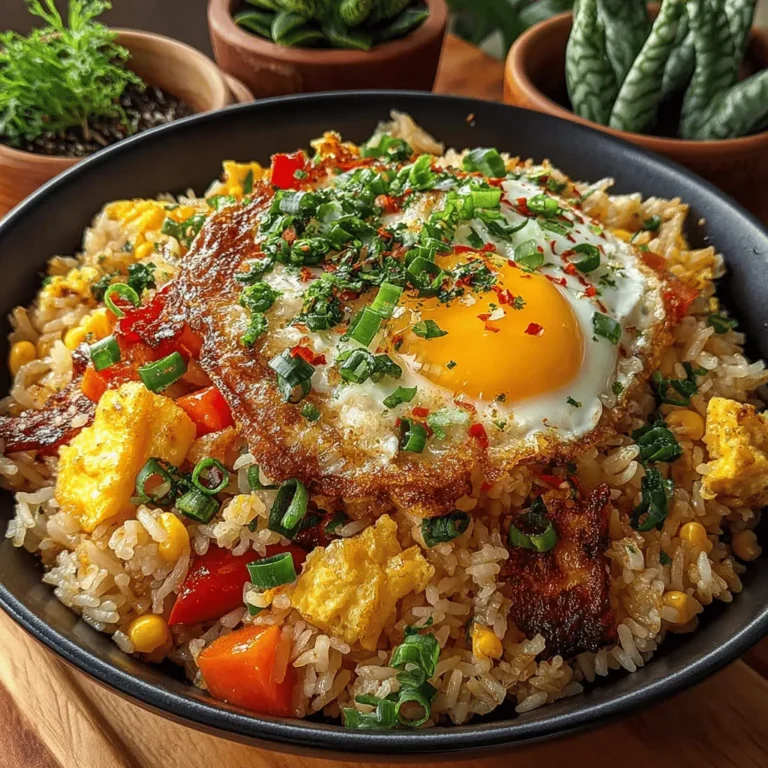Quick & Colorful Garden Fried Rice Recipe
Fried rice is a timeless dish that has found its way into kitchens around the globe, loved for its simplicity and adaptability. The Quick & Colorful Garden Fried Rice recipe stands out not only for its vibrant appearance but also for its ability to turn leftover ingredients into a satisfying meal. This dish is a celebration of fresh vegetables, hearty grains, and aromatic flavors, making it a go-to option for busy weeknights or a creative way to use up what you have on hand.
One of the best aspects of fried rice is its versatility. You can tailor the ingredients to suit your dietary preferences, seasonal produce, or even what needs to be cleared out of your refrigerator. Whether you’re a vegetarian, a meat lover, or somewhere in between, fried rice can accommodate a variety of tastes and dietary needs. This particular recipe showcases a medley of colorful vegetables, which not only adds visual appeal but also boosts the nutritional value of the dish.
Using leftover cooked rice is a key component of this recipe. Day-old rice, specifically jasmine rice, is the ideal choice because it has dried out slightly in the fridge, resulting in a firmer texture that holds up well during cooking. This prevents the rice from becoming mushy, a common pitfall when using freshly cooked rice. The combination of cooked rice and fresh vegetables creates a balanced meal that is both filling and nourishing.
Understanding the Ingredients
To create the perfect Quick & Colorful Garden Fried Rice, it’s essential to understand the role of each ingredient in the recipe. Here’s a closer look at the key components that contribute to this flavorful dish.
Cooked Jasmine Rice:
Using day-old jasmine rice is crucial for achieving the right texture in fried rice. Fresh rice tends to be sticky and clumps together, which can lead to an undesirable consistency in the final dish. The ideal rice for fried rice is slightly dried out, allowing each grain to separate easily during cooking. If you don’t have leftover rice, you can prepare fresh rice, spread it out on a baking sheet, and let it cool in the refrigerator for at least 30 minutes to achieve a similar effect.
Mixed Vegetables:
The beauty of this fried rice recipe lies in its colorful array of mixed vegetables. Common choices include diced carrots, sweet peas, bell peppers, and corn. Each of these vegetables brings a unique flavor and texture to the dish, while also adding essential vitamins and minerals. Incorporating a variety of vegetables not only enhances the nutritional profile but also makes the meal visually appealing, inviting you to dig in.
Eggs:
Eggs serve a dual purpose in this recipe. They provide a source of protein, which helps to make the dish more filling, and they also act as a binding agent, helping to hold the ingredients together. When scrambled and mixed into the rice, eggs add a rich, creamy texture that elevates the overall flavor.
Aromatics:
Garlic and green onions are the aromatic heroes of this dish. Garlic adds a robust flavor that complements the other ingredients, while green onions contribute a fresh, slightly pungent taste that brightens up the fried rice. Together, they create a fragrant base that enhances the entire dish.
Sauces:
Sauces are essential in fried rice, providing depth and richness to the overall flavor. Soy sauce and oyster sauce are the stars here. Soy sauce offers a salty umami flavor that enhances the natural taste of the ingredients, while oyster sauce adds a slightly sweet and earthy note. Together, they create a harmonious blend that takes your fried rice from ordinary to extraordinary.
Optional Garnishes:
To elevate the dish visually and flavor-wise, consider adding fresh herbs as garnishes. Chopped cilantro, basil, or a sprinkle of sesame seeds can add a pop of color and freshness, making your fried rice not just a meal, but a delightful presentation as well.
Preparation Steps Explained
Now that you have a solid understanding of the ingredients, let’s dive into the preparation steps for your Quick & Colorful Garden Fried Rice.
Preparing the Rice:
The first step in making this fried rice is preparing the rice itself. If you’re using leftover rice, make sure it’s stored correctly in the refrigerator. When reheating, break up any clumps with a fork to ensure even cooking. If you need to cook fresh rice, remember to cool it down before using it in the recipe. Spread it out on a baking sheet and let it chill in the fridge for at least 30 minutes. This step is crucial to prevent stickiness during frying.
Heating the Pan:
The key to successfully frying rice lies in the temperature of the pan. Use a large skillet or wok to allow enough space for the rice and vegetables to fry evenly. Heat the pan over medium-high heat until it’s hot. The right temperature allows the ingredients to sear rather than steam, giving you that coveted fried rice texture. Choose an oil with a high smoke point, such as vegetable oil or canola oil, for the best results. This will help achieve a nice, crispy texture without burning the ingredients.
Cooking the Eggs:
To ensure perfectly scrambled eggs, crack them into a bowl and beat them lightly before adding them to the hot pan. Pour the eggs into the skillet, allowing them to sit for a moment before gently stirring. This helps create soft curds rather than a rubbery texture. Once the eggs are cooked but still slightly runny, mix them into the rice later in the cooking process to prevent overcooking. This technique results in fluffy, tender eggs that enhance the dish without becoming dry or tough.
With these foundational steps in place, you’re ready to embark on your journey to create the perfect Quick & Colorful Garden Fried Rice. The combination of fresh ingredients, vibrant colors, and satisfying flavors will not only please your palate but also provide a nourishing and wholesome meal. Keep reading to discover how to bring all these elements together in the next part of the recipe!

Sautéing Aromatics
To create a deeply flavorful base for your Quick & Colorful Garden Fried Rice, start with the aromatics. The key ingredients here are garlic and onion, which will infuse the dish with a rich aroma and savory depth.
Timing and Technique for Maximizing Flavor from Garlic
When sautéing garlic, timing is crucial. Begin by heating your pan over medium heat and adding a splash of oil. Allow it to heat up before introducing the chopped onions. Sauté the onions until they become translucent, which usually takes about 3-5 minutes. Once the onions are ready, add the minced garlic. Garlic cooks quickly, so keep an eye on it. Sauté for about 30 seconds to 1 minute, until fragrant. The goal is to unlock the garlic’s essential oils without allowing it to brown too much, as burnt garlic can impart a bitter flavor.
How to Avoid Burning Aromatics During Cooking
To prevent burning the aromatics, consider lowering the heat slightly once the garlic is added. Stir constantly, and if you notice the edges beginning to brown, add a splash of broth or water to cool down the pan. This technique not only saves your aromatics but also helps create a flavorful base for the rest of the ingredients.
Adding Vegetables
The vibrant colors and textures of the vegetables are what make this dish truly a feast for the eyes and the palate.
Choosing the Right Vegetables for Texture and Color
Opt for a mix of seasonal vegetables that provide both crunch and color. Bell peppers, peas, carrots, and green onions are excellent choices. These vegetables not only add a beautiful visual appeal but also contribute essential vitamins and minerals. For a bit of heat, consider adding a few slices of fresh chili or a dash of sriracha.
Cooking Times for Maintaining Crispness While Ensuring Doneness
Add your vegetables to the pan immediately after the garlic. Start with the denser vegetables like carrots and bell peppers, as they require slightly longer to cook. Sauté these for about 2-3 minutes, allowing them to soften but not lose their crunch. Next, add the quicker-cooking vegetables like peas and green onions, cooking for an additional 1-2 minutes. The goal is to have all vegetables tender yet vibrant and crisp.
Combining Rice and Seasoning
Now that your vegetables are ready, it’s time to bring in the star of the dish: the rice.
Techniques for Breaking Up Clumps of Rice
If your rice has clumped together, don’t worry! Use a spatula to gently break apart the clumps as you add it to the pan. It’s best to use day-old rice, which has dried out slightly and is easier to work with. If you’re using freshly cooked rice, spread it out on a tray to cool for a few minutes before incorporating it into the dish.
How to Achieve an Even Distribution of Flavors with Sauces
Once the rice is added, pour in your sauces: soy sauce, a dash of sesame oil, and if you like, oyster sauce or a splash of rice vinegar for depth. Use your spatula to fold the rice gently into the vegetables, ensuring an even coating of sauce. This step is crucial for achieving that signature fried rice flavor and ensuring every bite is delicious.
Reintroducing Eggs and Finishing Touches
To add richness and protein to your Quick & Colorful Garden Fried Rice, it’s time to reintroduce the eggs.
Importance of Folding in Eggs Gently
If you pre-cooked your eggs, add them back into the pan now. It’s essential to fold them in gently to maintain their soft texture. Over-stirring can break them into tiny pieces, which might not be the desired outcome. You want soft curds that mingle with the rice and vegetables, adding creaminess to the overall dish.
How Sesame Oil Adds a Finishing Touch to the Dish
Finally, take your dish up a notch with a drizzle of sesame oil right before serving. This step not only enhances the flavor but also adds a lovely aroma. The nutty notes of sesame oil complement the dish beautifully, giving it that authentic fried rice taste.
Serving Suggestions
Now that your Quick & Colorful Garden Fried Rice is ready, it’s time to think about serving it.
Ideas for Pairing Fried Rice with Different Entrees
This dish is incredibly versatile and pairs beautifully with various entrees. Serve it alongside grilled chicken or shrimp for a complete meal. Alternatively, it can be a fantastic base for stir-fried tofu or a side dish to any Asian-inspired meal.
Creative Variations to Customize the Dish
Feel free to get creative with your fried rice! Add cooked proteins like chicken, shrimp, or tofu for a heartier dish. You could also experiment with different sauces, such as teriyaki or sweet chili, to give the dish your personal twist. For a unique flavor profile, consider adding nuts like cashews or almonds for an added crunch.
Suggestions for Presentation to Enhance Appeal
Presentation matters, especially with a dish so colorful! Serve the fried rice in a large bowl or plate, garnished with fresh herbs like cilantro or basil. A sprinkle of sesame seeds or chopped green onions on top can also elevate the visual appeal.
Nutritional Insights
This Quick & Colorful Garden Fried Rice is not only delightful but also packed with nutritional benefits.
Breakdown of Nutritional Benefits from Key Ingredients
The primary ingredients, such as rice, vegetables, and eggs, provide a well-rounded meal. Rice offers carbohydrates for energy, while the vegetables contribute essential vitamins and minerals. Eggs add high-quality protein, making this dish satisfying and nutritious.
Discussion on Balancing Meals with Fried Rice and Potential Health Considerations
Fried rice can be a balanced meal, especially when packed with colorful vegetables and lean proteins. However, be mindful of the sodium content in soy sauce. Opt for low-sodium versions if you’re watching your salt intake. Additionally, consider using brown rice for added fiber.
Importance of Incorporating a Variety of Vegetables for a Wholesome Dish
Incorporating a variety of vegetables not only enhances the flavor and texture but also boosts the nutritional profile of your fried rice. Aim for a rainbow of colors to ensure you’re getting a diverse range of nutrients.
Conclusion
In summary, this Quick & Colorful Garden Fried Rice is a stellar addition to your culinary repertoire. It’s quick, easy to prepare, and packed with flavor and nutrition. The versatility of this dish invites experimentation—feel free to play around with different ingredients and flavors until you find your perfect combination.
The art of home cooking lies in creativity and enjoyment, and this fried rice recipe exemplifies that philosophy. Gather your ingredients, let your imagination run wild, and savor the joy of creating beautiful, nutritious meals for yourself and your loved ones. Whether you’re an experienced cook or just starting out, this dish promises satisfaction and a burst of color on your plate. Enjoy the process and the delicious results!


